
While attending a national conference on social work, Dr. Jill Chonody came up with the idea of penning a textbook dedicated to the care of older adults – or rather, it was pitched to her.
“I was loudly complaining at the SAGE Publications booth that there aren’t any good social work textbooks on working with older adults and I was approached by an editor who happened to be standing nearby who asked if I might like to write one,” Chonody explained.
 Chonody teamed up with Dr. Barbra Teater, from City University at New York, College of Staten Island, to write the textbook. Together, the duo created a novel framework that merges social work values and ethics with the World Health Organization’s active aging policy, which stresses a strengths-based approach that promotes self-determination. Because of this, the book has an international focus, with each chapter pushing social work students to view their work through the lens of their clients’ strengths – that is, what are clients capable of doing instead of where their limitations are.
Chonody teamed up with Dr. Barbra Teater, from City University at New York, College of Staten Island, to write the textbook. Together, the duo created a novel framework that merges social work values and ethics with the World Health Organization’s active aging policy, which stresses a strengths-based approach that promotes self-determination. Because of this, the book has an international focus, with each chapter pushing social work students to view their work through the lens of their clients’ strengths – that is, what are clients capable of doing instead of where their limitations are.
The authors decided to give the book a broad, international focus because, as Chonody explained, it’s easy for students and social workers alike to assume our current practices and methods are the best in the world – and that is not necessarily true.
“In the Netherlands, there’s a place called Dementia Village for people who suffer from dementia,” Chonody said. “Instead of institutionalizing people like we do here, they’ve designed a full community with a grocery store, a post office, green spaces, a coffee shop and even a place to get your hair cut. The beauty is that the community is locked in, which means the patients are safe and they don’t have to pay for services. It makes them feel like they’re living in a village, not a dementia ward.”
One chapter focuses on “age-friendly cities” and how environmental factors greatly play into quality of life for older adults. Constructing an age-friendly city not only means examining air and water quality – which disproportionately impact both younger and older age groups — it means considering design elements like walkability, complete streets and allowing individuals to “age in place,” i.e. in their homes, for as long as they’re physically and mentally able.
“And when older adults are no longer able to live autonomously, how can we provide the best quality of care? What does that look like?” Chonody asked.
The Netherlands is once again on the forefront of exploring these questions. The country allows students – of any age – to live free in retirement homes. In exchange, the students are expected to spend a certain number of times per month hanging out and socializing with retirees.
“Housing can be really expensive there and this promotes intergenerational relationships,” Chonody said. “In general, our goal was to challenge students to reflect on positive and negative myths that promote ageism, and give them new perspectives on the six determinants of active aging, which are health, social, economic, physical, personal and behavioral,” said Chonody.
The book concludes with a look to the future of practice with an eye toward technology, aging in place and community-driven services.